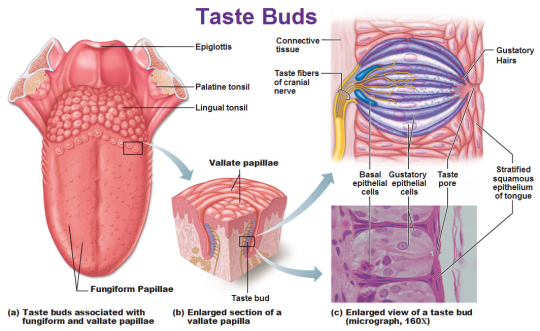#gustatory
The tongue is covered with many little bumps called papillae.Taste buds are found in the walls of papillae and the grooves surrounding them. Each taste bud contains anywhere from 50 to 150 taste receptor cells.
- Microvilliextend from taste receptor cells
- and protrude through an opening (taste pore) into the mouth.
- These microvilli come in contact with substances in the mouth that can be tasted, also known as tastants.
- Tastants interact with taste receptor cells through a number of different mechanisms to depolarize the cells.
- When taste cells are depolarized, they release neurotransmitters that stimulate sensory neurons that travel in cranial nerves VII, IX, and X.
- These neurons terminate on neurons in the nucleus of the solitary tract in the medulla then continue on to the thalamus.
- Taste information is sent to the gustatory cortex, ( ocated on the border between the anterior insula and the frontal operculum).
- This information encodes for basic tastes, such as sweet, salty, sour, bitter, and savory or umami.
- However, the actual flavour of a food—which is what we typically define as taste—is created by a combination of taste and olfactory (smell) information.

Sweetness
- Produced by the presence of sugars, some proteins, and other substances.
- Detected by G protein-coupled receptors T1R2+3 (heterodimer) and T1R3 (homodimer).
Saltiness
- Saltiness is a taste produced best by the presence of cations (such as Na+, K+or Li+)
- Directly detected by cation influx into glial like cells via leak channels causing depolarisation of the cell.
Sourness
- Sourness is acidity and is also sensed using ion channels.
- Undissociated acid diffuses across the plasma membrane of a presynaptic cell, where it dissociatesin accordance with Le Chatelier’s principle.
- Theprotons that are released then block potassium channels, which depolarise the cell and cause calcium influx.
Bitterness
- Current research suggests TAS2Rs (taste receptors, type 2, also known as T2Rs) such as TAS2R38 are responsible tasting bitter substances.
Savouriness
- The amino acid glutamic acid is responsible for savouriness, but some nucleotides (inosinic acid and guanylic acid) can act as complements.
- Glutamic acid binds to a variant of the G protein-coupled receptor, producing a savoury taste
